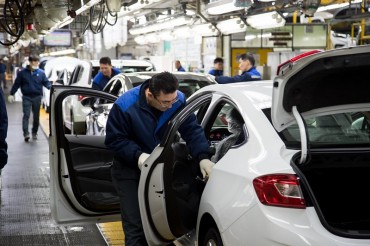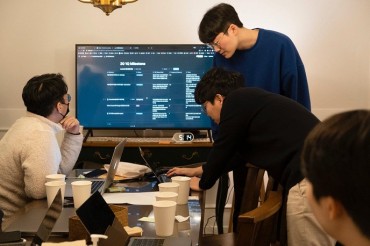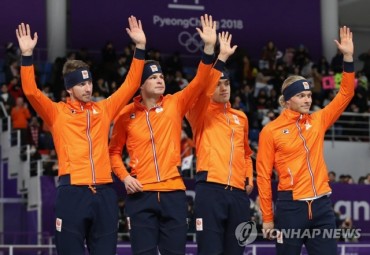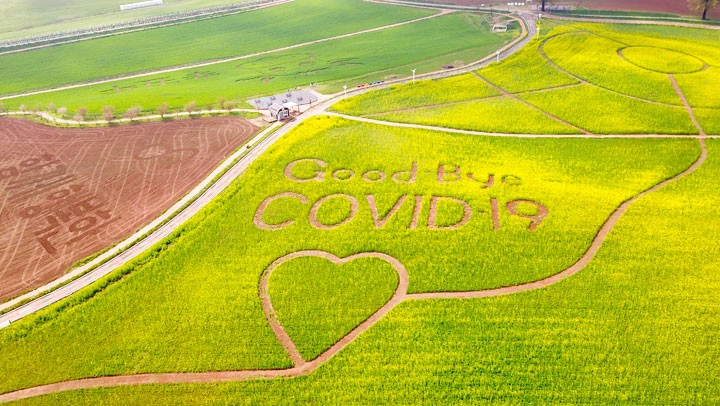
This bird eye’s view shot of Anseong Farmland park in Gyeonggi Province on April 18, 2021, shows visitors at the park’s flower field with the phrase “Good Bye COVID-19.” (Yonhap)
SEOUL, April 18 (Korea Bizwire) — South Korea’s daily new coronavirus cases stayed in the 600s for the fourth consecutive day Sunday as sporadic infections continue to pop up across the nation, complicating antivirus efforts against the fourth wave of the pandemic.
The country reported 672 more COVID-19 cases, including 649 local infections, raising the total caseload to 114,115, the Korea Disease Control and Prevention Agency (KDCA) said.
It added three more deaths, raising the total to 1,797.
The average daily number of locally transmitted cases was 621 over the past week, and the proportion of untraceable virus cases stood at 27.7 percent during the period, the KDCA said.
The reproduction rate for stood at 1.14, it said, which means a single COVID-19 patient transmits the disease to more than one person.
As of 9 p.m., health authorities and local governments reported 481 new virus cases across the country, down 142 from the same time on Saturday. The decrease appears to have been largely caused by fewer tests conducted over the weekend.
Health authorities cautioned against a hike in group infections in public places, including sports facilities, churches, karaoke rooms, restaurants, workplaces and schools, as people increased outdoor activities in the spring season with the vaccination program under way.
Last week, the country decided to maintain the current level of social distancing rules through May 2 to contain the virus, while banning operations of entertainment establishments in the greater Seoul area and the southeastern port city of Busan.
The greater Seoul area, home to half of the nation’s 52 million population, is under the Level 2 distancing scheme, the third highest in the five-phase system.
The rest of the country is under Level 1.5, except for some municipalities that have adopted Level 2 measures.
Officials warned of tougher rules on multiuse facilities and business operations if the current infection trend continues.
A total of 94 people from India have been confirmed as infected with the coronavirus since January, and nine of them were discovered to be Indian variant, Sohn Young-rae, a senior health official, said in a briefing.
“As there is scarce information on the transmission and fatality rate (of the Indian variant), authorities are monitoring the outbreak,” Sohn said.
Since the country started its vaccination program on Feb. 26, a total of 1,512,503 people, or 2.91 percent of total population, have been given COVID-19 vaccine shots, including 29,165 the previous day.
AstraZeneca’s vaccine has been given to 1,000,235 people, while 512,268 received that of Pfizer.
The KDCA said 60,585 people have received two doses.
A total of 12,197 cases of side effects after vaccinations have been reported, up 78 from a day earlier, but 98.3 percent were mild symptoms, including muscle pain and fever.
A total of 56 deaths after vaccinations have been reported, according to the KDCA. Authorities, however, said most cases were not related to the vaccinations.
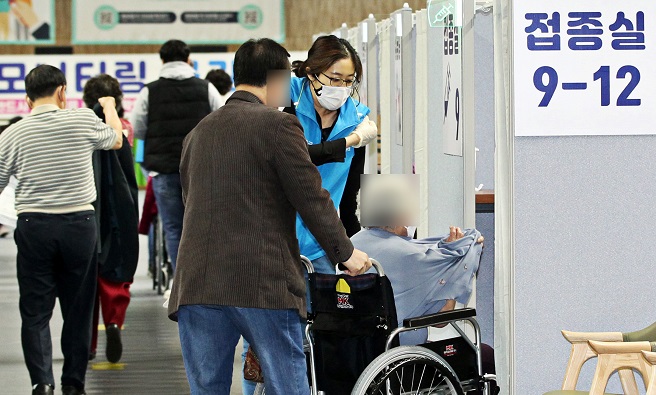
A senior in a wheelchair gets ready for inoculation with Pfizer’s COVID-19 vaccine at a vaccination center in southern Seoul on April 17, 2021, in this photo provided by the Dongjak Ward Office.
Finance Minister Hong Nam-ki said the government will redouble efforts to secure sufficient vaccine supply and speed up the inoculation drive to achieve herd immunity by November.
“(The government) aims to vaccinate 3 million people by April and 12 million in the first half of this year,” Hong, who serves as an acting prime minister, said in a virus response meeting.
The KDCA earlier said that it has secured enough coronavirus vaccines to inoculate 79 million people, more than its 52 million population, but the supply glitch and safety issues have raised concerns over delay in the vaccine program.
The vaccination coordination team said it will recommend people to receive the second jab of AstraZeneca’s vaccine within 11-12 weeks of the first one, shorter than the 8-12 weeks it previously advised, to raise its efficacy and considering the vaccine supply.
AstraZeneca earlier said an extended interval of 12 weeks between shots demonstrated even greater efficacy in previous trials.
The health authority said it will study the potential need to secure additional doses of COVID-19 vaccine as the U.S. government was considering a booster shot to better defend against coronavirus variants.
Top executives of Pfizer and Moderna said last week that people who have received both doses of their vaccines will probably need a booster shot this year.
Of the newly confirmed locally transmitted cases, 202 came from Seoul, with Gyeonggi Province surrounding the capital city reporting 181 cases.
Cluster infections continue to hamper the antivirus campaign.
The number of cases traced to an entertainment bar in the southeastern port city of Busan swelled to 480, up four from the previous tally, while a church in Dangjin, South Chungcheong Province, added four new patients for a total of 69.
The number of cases traced to a private meeting in the southeastern city of Jinju grew by eight to 48.
There were 23 additional imported cases, with 15 from Asian nations excluding China and three from the United States.
The number of seriously or critically ill COVID-19 patients was 102, down six from the previous day.
The total number of people released from quarantine after making full recoveries was 104,006, up 412 from a day earlier.
(Yonhap)



![[Feature] Picture Taking at Polling Stations Becomes a National Fad [Feature] Picture Taking at Polling Stations Becomes a National Fad](http://koreabizwire.com/wp/wp-content/uploads/2014/06/picture-taking-370x403.png)
